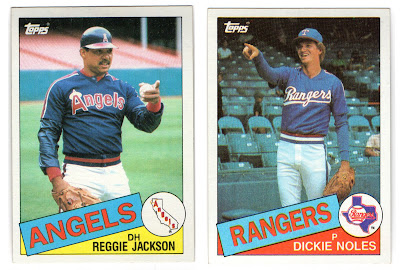Sunday, August 29, 2021
From the Favorites Box: Robin Yount, 1978 Topps #173
Sunday, August 22, 2021
The 1982-83 O-Pee-Chee Dating Game (Episode 19)
Previous episodes are available here.
The big winner of episode 18 was the appropriately named Chris Valentine.
Now, let's start the 19th round and introduce the bachelors chosen by the randomizer! [APPLAUSE]
Sunday, August 15, 2021
Alou Brothers
1968 Topps #55 Felipe Alou, #270 Matty Alou, and #452 Jesus Alou |
CAREER TOTALS
|
|
FELIPE (17 seasons) |
MATTY |
JESUS (15 seasons) |
|
GAMES PLAYED |
2082 |
1667 |
1380 |
|
AT-BATS |
7339 |
5789 |
4345 |
|
RUNS |
985 |
780 |
448 |
|
HITS |
2101 |
1777 |
1216 |
|
DOUBLES |
359 |
236 |
170 |
|
TRIPLES |
49 |
50 |
26 |
|
HOME RUNS |
206 |
31 |
32 |
|
RBI |
852 |
427 |
377 |
|
STOLEN BASES |
107 |
156 |
31 |
|
WALKS |
423 |
311 |
138 |
|
STRIKEOUTS |
706 |
377 |
267 |
|
BATTING AVERAGE |
.286 |
.307 |
.280 |
|
OBP |
.328 |
.345 |
.305 |
|
SLG |
.433 |
.381 |
.353 |
BEST INDIVIDUAL SEASON
(Career highs in bold; asterisk = led major leagues)
|
|
FELIPE (1966, ATL) |
MATTY |
JESUS (1965, SF) |
|
GAMES PLAYED |
154 |
162 |
143 |
|
AT-BATS |
666* |
698* |
543 |
|
RUNS |
122* |
105 |
76 |
|
HITS |
218* |
231* |
162 |
|
DOUBLES |
32 |
41* |
19 |
|
TRIPLES |
6 |
6 |
4 |
|
HOME RUNS |
31 |
1 |
9 |
|
RBI |
74 |
48 |
52 |
|
STOLEN BASES |
5 |
22 |
9 |
|
WALKS |
24 |
42 |
13 |
|
STRIKEOUTS |
51 |
35 |
40 |
|
BATTING AVERAGE |
.327 |
.331 |
.298 |
|
OBP |
.361 |
.369 |
.317 |
|
SLG |
.533 |
.411 |
.398 |
Sunday, August 8, 2021
Go West, Custom Card
First, here's the original card, featuring actor Forrest Tucker smiling on a sunny day at the ranch.
 |
| 1953 Topps Who-Z-At Star #3, Forrest Tucker |
Any ideas on who the look-alike football star is? Here are some hints:
He's somewhat recently retired.
In retirement, he's been known to appear in an occasional television commercial.
Those Western-named football teams? The Colts and the Broncos.
Enough hints? Okay, here's the custom card.
Forrest Tucker
had early acting success in the late 1930s and early 1940s, and then
enlisted in the US Army during World War II. He resumed his acting career
after the war. Notably, he played alongside top actors like Errol Flynn, Gary
Cooper, John Wayne, and Randolph Scott.
Here are just some of the famous films in which he appeared: The Yearling (1946), Sands of Iwo Jima (1949), Pony Express (1953). Aside from the silver screen, Tucker also played the character of Sergeant Morgan O'Rourke in the TV show F Troop, and even appeared on a few episodes of Gunsmoke.
As for Peyton Manning, you might know a thing or two about him, even if you're not a football fan. Here's a brief indication of his success:
17 seasons played
14x Pro Bowl
7x All-Pro
5x MVP
2 Super Bowl victories (2006 Colts, 2015 Broncos)
In 266 games, he went 186-79, posting a 65.3 completion percentage, 71,940 passing yards, and 539 passing touchdowns. He finished his career with an average of 7.7 yards per pass attempt.
Further proof of his greatness? As of this writing, 71,940 passing yards puts him at #3 all time, behind only Drew Brees and Tom Brady. 539 passing touchdowns also puts him at #3 behind the same two guys.
He's in the top 10 in career completion percentage (65.3) and the top 5 in passes completed (6,135).
And that's that. Another fun custom card in the books. How many of you guessed the look-alike this time around?
Thanks for reading, as always.
Sunday, August 1, 2021
Completed Set: 1985 Topps Baseball
Firstly, it's the design. As you look through the cards below I think you might agree that it's better than average. The cards are bright. Bold. Fun. And on top of all that, the colors are very well matched to each team's colors. That's a departure from the previous few years, when Topps chose colors that sometimes provided a nice complement to the team's colors, and other times did not. (For example, 1980 Topps Pirates cards received a purple and orange combo, while 1982 Topps Cardinals cards were hit with magenta and brown.)
And there you have 1985 Topps baseball. It's a nice-looking set. Bright. Colorful. Bold lines. The cards look good in nine-pocket pages. It's also quite affordable—even more so if you've already got the "big three" rookie cards. I'm very happy to have completed this one.
What are your thoughts on the set? Share in the comment section, and thanks for reading, as always.































